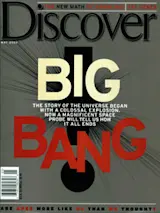This month it won't be easy to distinguish real sky drama from hype. A so-called grand conjunction, in which Mercury, Venus, Mars, Jupiter, and Saturn line up with the Earth, sun, and moon, has generated a New Age buzz with its own cryptic warning label: Beware 5-5-00. On that date, doomsayers claim, gravitational forces reverberating throughout the solar system will trigger earthquakes and volcanoes on Earth.
Beyond the spooky nickname, however, the grand conjunction is a celestial dud. On May 3 and 4, an extremely slender crescent moon and five planets will cluster in a 26-degree-wide swath of sky. The planets remain bunched most of the month after the moon has marched on and actually reach their tightest configuration on May 17. But because the planets are roughly aligned with the sun, the whole thing is utterly lost in solar glare. There's nothing to see.
The gravitational consequences of the grand conjunction are equally unimpressive. All of the planets are so far away from Earth that their pull is tiny compared to that of the sun or moon. The additional tide raised by an unusually close full moon--such as occurred in December--is a thousand times stronger than the influence of all the planets combined, and even that only raises the high-water mark by a few extra inches. The total planetary tides in May will actually be below mean because Venus and Jupiter, the planets with the strongest gravitational effects on Earth, will be on the far side of the sun.
What's more, a five-planet conjunction is not such a rare event. Similar groupings occur every few years. In 1982 all the planets except Pluto gathered on one side of the sun. There were plenty of warnings then, too, and they proved to be completely without merit. Cross-checks show that there is no correlation between past planetary alignments and terrestrial events, such as tremors and volcanic eruptions.
The real story this month is the power the sky still holds over the superstitious. Even as space probes scrutinize our neighbors in the solar system, many Earthlings cling to the belief that heavenly bodies can exert control over human affairs.
Ancient folklore says the full moon can drive you mad. But mental hospitals show no higher admission rates then than at any other time. Many otherwise sensible health officials will tell you more babies are born around the time of full moons. Nonsense--a look at birth records shows no relationship whatsoever.
Not that there's anything wrong with feeling a connection between heaven and Earth. Astronomers are finding that the universe does influence life on Earth, in marvelous and quite unexpected ways. Solar storms affect our climate and communications systems. The phases of the moon are statistically linked with rainfall, for reasons yet unknown. Amino acids, the possible precursors of the first living things on Earth, routinely arrive here on comets.
The warming evenings of May are a fine time to look up and reflect on these links to the cosmos. Just don't take any bets on volcanoes going off on 5-5-00.

To learn about all the things that don't happen under a full moon, see the comprehensive debunking of full-moon myths at www.skepdic.com/fullmoon.html.














